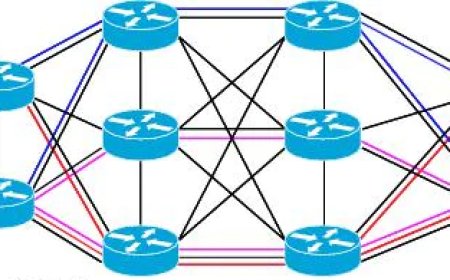Server Types Explained
Ten of the server types are described in this post. This post also gives information about how these server work and what are thy type of these servers.

1. WEB SERVER
Shortly, Web Servers serve as the backbone of the World Wide Web. They are responsible for handling requests from browsers and delivering web pages to users. In this post, you will find what web servers are, how they work, and the different types of web servers available.
A web server is a computer program that uses the HTTP protocol to deliver web pages to clients over the internet. When a user types a URL into their browser, the browser sends an HTTP request to the web server associated with that URL. The web server then processes the request and returns the requested web page to the browser, which displays it on the user's screen.
Web servers can be broadly categorized into two types: static and dynamic. Static web servers are designed to deliver pre-written HTML pages to users. These pages are stored on the server and are delivered as-is to the client. Dynamic web servers, on the other hand, can generate web pages on the fly based on information stored in a database or other data source. These servers use server-side scripting languages such as PHP, Ruby, or Python to generate the HTML pages, which are then delivered to the client.
2. FILE SERVER
Today, file servers are critical for all organizations. They provide a central location for storing and managing files that can be accessed by users across the network.
A file server is a computer or device that stores and manages files on a network. It allows multiple users to access, store, and share files from a single location. File servers use protocols like SMB (Server Message Block) or NFS (Network File System) to enable file sharing and collaboration. This allows users to access and edit files from different devices and locations, making it easy for teams to work together.
File servers can be broadly categorized into two types: centralized and distributed. Centralized file servers store all files in a single location, and users access them over the network. Distributed file servers, on the other hand, store files in multiple locations and use a distributed file system to manage them. This allows for faster access to files, improved scalability, and increased reliability.
One of the recent trends in file servers is the adoption of cloud-based file servers. These servers store files in the cloud, which allows for easy access from anywhere, and also provides better scalability and disaster recovery options. Additionally, it also allows for easy collaboration and sharing of files with remote team members and also enables easier backups and restoration of files.
3. DATABASE SERVER
Before You Start: Step by Step - Installing SQL Server 2019 - superuser (kbsuperuser.com)
Database servers are a fundamental component of modern IT systems, providing fast and reliable storage and management of large amounts of data.
A database server is a computer program that manages a database, providing access to the stored data to other programs or users. It uses a specific type of software called a database management system (DBMS) to organize and manage the data. There are many different types of DBMSs available, including MySQL, SQL Server, Oracle, and PostgreSQL, each with its own set of features and capabilities.
Database servers can be broadly categorized into two types: relational and non-relational. Relational database servers use tables to store data and use SQL (Structured Query Language) to access and manipulate the data. Non-relational database servers, on the other hand, use a different data model, such as documents or key-value pairs, and may use a different query language.
One of the recent trends in database servers is the adoption of cloud-based database servers. These servers store data in the cloud, which allows for easy access from anywhere, and also provides better scalability and disaster recovery options. Additionally, it also allows for easy collaboration and sharing of data with remote team members and also enables easier backups and restoration of data.
4. GAME SERVER
Game servers are an integral part of the online gaming experience, enabling players to connect and play together in a virtual world.
A game server is a computer program that hosts and runs an online multiplayer game. It handles the communication between players and provides a central location for storing game data. Game servers use protocols like TCP/IP and UDP to enable players to connect and interact with each other in real-time.
Game servers can be broadly categorized into two types: dedicated and shared. Dedicated game servers are dedicated to a single game and are usually owned and operated by the game's publisher or developer. Shared game servers host multiple games and are usually owned and operated by third-party companies.
Another recent trend in game servers is the adoption of cloud-based game servers. These servers store the game data in the cloud, which allows for easy access from anywhere and also provides better scalability and disaster recovery options. Additionally, it also allows for easy collaboration and sharing of data with remote team members and also enables easier backups and restoration of data.
5. APPLICATION SERVER
Application servers provide a platform for hosting and running application software.
An application server is a software framework that provides a platform for developing and running web applications. It handles the communication between the web server and the application, and provides a set of services and APIs for the application to use. Examples of application servers include Java EE, .Net, and Ruby on Rails.
Application servers can be broadly categorized into two types: open-source and proprietary. Open-source application servers are free to use and are usually developed and maintained by a community of developers. Proprietary application servers are owned and operated by a single company and may require a license to use.
Another recent trend in application servers is the adoption of cloud-based application servers. These servers provide a platform for developing and running web applications in the cloud, which allows for easy access from anywhere and also provides better scalability and disaster recovery options. Additionally, it also allows for easy collaboration and sharing of data with remote team members and also enables easier backups and restoration of data.
6. MAIL SERVER
Before You Start: Step by Step - Installing Microsoft Exchange Server 2019 - superuser (kbsuperuser.com)
Briefly, mail servers enable users to send and receive emails.
A mail server is a computer program that manages email communications. It receives incoming emails from other mail servers, stores them, and then delivers them to the intended recipients. It also handles the sending of emails from users on the network. Mail servers use protocols like SMTP (Simple Mail Transfer Protocol) and POP (Post Office Protocol) or IMAP (Internet Mail Access Protocol) to send and receive emails.
Mail servers can be broadly categorized into two types: inbound and outbound. Inbound mail servers receive incoming emails and deliver them to the intended recipients. Outbound mail servers, on the other hand, handle the sending of emails from users on the network. Some mail servers can perform both functions, these are known as full-featured mail servers.
Another recent trend in mail servers is the adoption of cloud-based mail servers. These servers store emails in the cloud, which allows for easy access from anywhere and also provides better scalability and disaster recovery options. Additionally, it also allows for easy collaboration and sharing of emails with remote team members and also enables easier backups and restoration of emails.
7. FTP SERVER
FTP servers provide a way to transfer files over the internet.
An FTP (File Transfer Protocol) server is a computer program that enables the transfer of files between computers over the internet. It uses the FTP protocol to transfer files between an FTP client and the server. FTP servers can be used to transfer files of any size and type, including text, images, and executable programs.
FTP servers can be broadly categorized into two types: standard and secure. Standard FTP servers use the original FTP protocol and are vulnerable to eavesdropping and tampering. Secure FTP servers, on the other hand, use a secure version of the FTP protocol, such as SFTP (Secure File Transfer Protocol) or FTPS (FTP Secure) to encrypt the data transfer and to authenticate the users.
Another recent trend in FTP servers is the adoption of cloud-based FTP servers. These servers store files in the cloud, which allows for easy access from anywhere and also provides better scalability and disaster recovery options. Additionally, it also allows for easy collaboration and sharing of files with remote team members and also enables easier backups and restoration of files.
8. DNS SERVER
Before You Start: What is DNS and How DNS works? - superuser (kbsuperuser.com)
DNS servers provide a way to translate domain names to IP addresses.
A DNS (Domain Name System) server is a computer program that translates domain names, such as www.example.com, into IP addresses, such as 192.168.1.1. It is an essential component of the internet infrastructure, allowing users to access websites and other online resources using easy-to-remember domain names, rather than IP addresses.
DNS servers can be broadly categorized into two types: recursive and authoritative. Recursive DNS servers are used by clients to resolve domain names, they request the IP address from an authoritative DNS server. Authoritative DNS servers store the IP address and other information about a domain name, and respond to requests from recursive servers.
Another recent trend in DNS servers is the adoption of cloud-based DNS servers. These servers store DNS information in the cloud, which allows for easy access from anywhere, and also provides better scalability and disaster recovery options. Additionally, it also allows for easy collaboration and sharing of DNS information with remote team members and also enables easier backups and restoration of DNS information.
9. VPN SERVER
VPN servers provide a secure and private connection to the internet.
A VPN (Virtual Private Network) server is a computer program that enables users to securely connect to a private network over the internet. It uses encryption and other security measures to protect the data being transmitted, providing a secure and private connection. VPNs are commonly used by businesses and organizations to provide remote access to their networks, as well as by individuals to protect their privacy and security online.
VPN servers can be broadly categorized into two types: remote-access and site-to-site. Remote-access VPN servers are used by individuals and mobile users to connect to a private network from a remote location. Site-to-site VPN servers are used by businesses and organizations to connect multiple remote locations to a private network.
Another recent trend in VPN servers is the adoption of cloud-based VPN servers. These servers allow users to connect to a private network in the cloud, which allows for easy access from anywhere, and also provides better scalability and disaster recovery options. Additionally, it also allows for easy collaboration and sharing of data with remote team members and also enables easier backups and restoration of data.
10. PROXY SERVER
Proxy servers provide a way to improve internet security and performance.
A proxy server is a computer program that acts as an intermediary between a client and a server. It receives requests from clients, forwards them to the appropriate server, and then returns the server's response to the client. Proxy servers can be used to improve internet security, performance, and access to blocked content.
Proxy servers can be broadly categorized into two types: transparent and anonymous. Transparent proxy servers do not hide the client's IP address and are typically used to improve performance by caching frequently requested content. Anonymous proxy servers, on the other hand, hide the client's IP address and are typically used to protect a user's privacy and access blocked content.
Another recent trend in proxy servers is the adoption of cloud-based proxy servers. These servers provide a way to improve internet security and performance by using servers in the cloud, which allows for easy access from anywhere, and also provides better scalability and disaster recovery options. Additionally, it also allows for easy collaboration and sharing of data with remote team members and also enables easier backups and restoration of data.
What's Your Reaction?

























